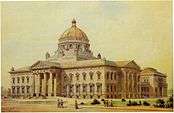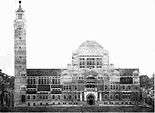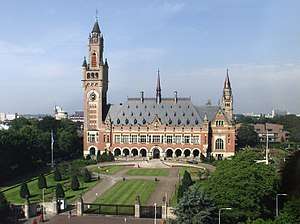Architectural design competition
An architectural design competition is a type of design competition in which an organization that intends on constructing a new building invites architects to submit design proposals. The winning design is usually chosen by an independent panel of design professionals and stakeholders (such as government and local representatives). This procedure is often used to generate new ideas for building design, to stimulate public debate, generate publicity for the project, and allow emerging designers the opportunity to gain exposure. Architecture competitions are often used to award commissions for public buildings: in some countries rules for tendering public building contracts stipulate some form of mandatory open architectural competition.[1]
Winning first prize in a competition is not a guarantee that the project will be constructed. The commissioning body often has the right to veto the winning design, and both requirements and finances may change, thwarting the original intention. The 2002 World Trade Center site design competition is an example of a highly publicized competition where only the basic elements of the winning design by Daniel Libeskind appeared in the finished project.
History
Architecture competitions have a more than 2,500-year-old history. The Acropolis in Athens was a result of an architectural competition in 448 B.C., as were several cathedrals in the Middle Ages. During the Renaissance, many projects initiated by the church have been decided through design competition. Examples are the Spanish Stairs in Rome or in 1419, a competition was held to design the dome of the Florence Cathedral, which was won by Filippo Brunelleschi. Open competitions were held in the late 18th century in several countries including the United States, Great Britain, Ireland, France and Sweden.[2]
In 19th century England and Ireland there have been over 2,500 competitions in five decades, with 362 in London alone. The Institute of British Architects drafted a first set of rules in 1839, and a set of formal regulations in 1872. The German Regulations were introduced in 1867. In the same period in the Netherlands, an association for the advancement of architecture (Maatschappij tot Bevordering van de Bouwkunst), started organising conceptual competitions with the aim of stimulating architects' creativity.[3]




Entries (from left to right) by Otto Wagner, Franz Heinrich Schwechten, Hendrik Petrus Berlage and built design by Louis M. Cordonnier
Competition types
There are a variety of competition types resulting from the combination of following options:[4]
- Open competitions (international, national or regional) or limited, selected, non-open competitions, depending on who is allowed to participate.
- Project competitions or ideas competitions: depending on the intention of building the project or generating new ideas.
- Single-stage or two-stage competitions: depending on the scale and complexity of the competition.
- Anonymous or cooperative procedures: anonymity supports greater objectivity during the evaluation and award-granting deliberations. In cooperative procedures, the authors are invited to make in-person presentations to the jury in order to explain their design strategies and allow individual discussion.
- Student design competitions.
Rules and guidelines
The rules of each competition are defined by the organiser; however, these often follow the guidelines provided by the International Union of Architects,[5] respectively the relevant national or regional architecture organisation. Competition guidelines define roles, responsibilities, processes, and procedures within a competition[6] and provide guidance on possible competition types, eligibility criteria, jury composition, participation conditions, payments, prizes, publication of results and other aspects.[7][8]
In France and Germany design competitions are compulsory for all public buildings exceeding a certain cost.[1][9]
Major international architectural design competitions
Most significant among architectural competitions are the ones which are internationally open, attract a large number of design submissions, and the winning design is built.
See also
References
- 1 2 Jacques Cabanieu: Competitions and Architectural Excellence, in Places 9:2, MIT, 1994, retrieved 2009-09-25
- ↑ 130 Years of Finnish architectural competitions, retrieved 2009-09-23
- ↑ De Jong, Cees and Mattie, Erik: Architectural Competitions 1792-1949, Taschen, 1997, ISBN 3-8228-8599-1
- ↑ "Guidelines for Architectural Design Competitions" (PDF). Australian Institute of Architects. October 2003. Retrieved 12 September 2013.
- ↑ UIA competition guide Archived 14 July 2009 at the Wayback Machine., retrieved 2009-10-10
- ↑ Canadian competition rules Archived 9 October 2009 at the Wayback Machine., retrieved 2009-10-10
- ↑ Finnish competition rules, retrieved 2009-10-10
- ↑ Indian competition guidelines Archived 12 December 2009 at the Wayback Machine., retrieved 2009-10-10
- ↑ German competition guidelines Archived 25 September 2015 at the Wayback Machine., retrieved 2015-09-24
Further reading
- Andersson E., Bloxham Zettersten, G. und Rönn, M., (eds) Architectural Competitions - Histories and Practice. Stockholm: The Royal Institute of Technology and Rio Kulturkooperativ, 2013. ISBN 978-91-85249-16-9
- Chupin, Jean-Pierre, Carmela Cucuzzella and Bechara Helal (eds) Architecture Competitions and the Production of Culture, Quality and Knowledge: An International Inquiry, Montreal: Potential Architecture Books, 2015, ISBN 978-0-9921317-0-8
- Collyer, G. Stanley, Competing Globally in Architecture Competitions, Wiley Academy, 2004, ISBN 0470-86-2130
- De Jong, Cees and Mattie, Erik: Architectural Competitions 1792-1949, Taschen, 1997, ISBN 3-8228-8599-1
External links
| Wikimedia Commons has media related to Architectural competitions. |
- Architectural Competition - Nordic Symposium
- Canadian Competitions Catalogue
- DesignCompetition.com, list of design competitions
- CABE: Making Competitions Work
- RIBA Competitions, the Royal Institute of British Architects dedicated RIBA Competitions unit
- Wettbewerbe Aktuell, a German journal specialized in architectural competitions
- Handbook of Architectural Design Competitions, American Institute of Architects (AIA)
- The Competition Project, Inc., a world-wide resource on competitions since 1990 with the periodical publication, COMPETITIONS (1991-2010) and COMPETITIONS Annual (2010-)